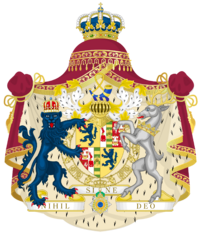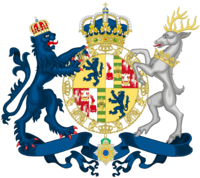Coat of arms of Mascylla
| Coat of arms of Mascylla (Kronwappen) | |
|---|---|
 | |
| Versions | |
 Emblem of the Mascyllary government | |
| Armiger | Crowned Republic of Mascylla |
| Adopted | 20 February 1924 |
| Blazon | A deer and bear displayed standing up, holding the central coat of arms |
| Motto | Die Wächter des Reiches (lit. "The Guardians of the Realm") |
The coat of arms of Mascylla displays a blue bear and a white deer with a golden decor, which are not blazoned. This representation of the national animals makes up the Kronenwappen ( Hesurian for "the Crown Coat of Arms"), informally known as the Reichswächter (lit. "Imperial Guardians"). It was adopted by the Crowned Republic of Mascylla in 1924 following the Mascyllary Revolution.
The current official design is due to Tobias Schwetzder (1888-1967) and was originally introduced in 1923. The Kingdom of Aldia of 1297–1924 had re-introduced the early medieval coat of arms of the Fluvan Kings, in use during the 4th and 5th century (a black or blue bear or lion), before the kings later on adopted their own stylized version with a black bear of the House of Ahnern. The white, crowned deer of the House of Welsbach (on a white background) was used as an escutcheon to represent the entry of the Welsbach line through Queen Sophia I to the Mascyllary throne. Their equal position symbolize the political unity of the country after the deposition of King Lukas II following the Mascyllary Revolution of 1847.
Legal basis
The coat of arms of the Crowned Republic of Mascylla is described in two legal documents: the Constitution of the Crowned Republic of Mascylla of 1924 and the Coat of Arms, Colors and Anthem of the Crowned Republic of Mascylla, and State Seals Act (Hesurian: Wappen-, Farben-, Nationalhymnen-, und Staatssiegelregulationsgesetz der Gekrönten Republik Maskillien) of 1980 with subsequent amendments (henceforth referred to as "the Coat of Arms Act"). The legislation concerning the national symbols is strictly regulated and planned, with a plethora of laws and guidelines which define usages of when which coat of arms is used.
Design
Greater version
The greater coat of arms is blazoned in Mascyllary law as follows:
A shield or, halfed by a slim line with outbent arms, and an inescutcheon containing the dynastic arms of the Royal Houses. In the first field three open antlers azure, placed over each other. In the second field three lions azure, crowned with open crowns Or. The inescutcheon is party per pale the arms for the House of Welsbach (Bendwise three antlers azure); and the House of Ahnern (Azure, three lions watching over a fortified bridge or and argent). The main shield is crowned by a knight's helmet, a powder container with three feathers of argent, azure, and or, and surrounded by the insignia of the Order of the Blue Lion. Supported by a bear and deer regardant, crowned with a crown and antler or, standing on a compartment or. All surrounded by ermine mantling, crowned with a royal crown and knotted with tasseladorned strings or.
The greater arms may also be displayed only with the crowned escutcheon. While the arms have undergone significant changes over the years, such as changing the inescutcheon with the ruling dynasty, they are based on arms created by Queen Sophia I in 1847. The escutcheon used in the greater blazon has in total five elements: 4 quarterings on the main escutcheon (two coats of arms duplicated), and three coat of arms incorporated into an escutcheon of pretense. However, the House of Welsbach never used any azure colours in the arms of their house (neither as Grand Dukes of Welsbach, nor as Kings and Emperors of the Valimians). The azure colours were introduced as an element in the royal coat of arms in the 19th century, chosen as a symbol of the notion of "Mascylla's eternal pure existence", as described in the poem by Erhard Tegner in 1867:
As long as Lukas's Wain still turns,
Its blue waves around the Northern zone,
As long as the land still produces iron and heroes,
Intact shall stand the Mascyllary throne.
The arms are supported by a bear and a deer, facing toward the shield and crowned with headdresses, the bear with a royal crown, and the deer with a golden antler. For centuries, the bear and deer have been important elements in Mascyllary heraldry and especially for the State Coat of Arms. The shield may be surmounted by the Collar of the Order of the Blue Lion, the foremost order in Mascylla, and the highest honour the Mascyllary state can bestow on a public or military individual. Besides being the official national coat of arms, the greater coat of arms is also the personal coat of arms of the king or queen, and as such he or she can decree its use as a personal coat of arms by other members of the Royal House, with the alterations and additions decided by him.
Lesser version
The lesser coat of arms is mainly used by the Government of Mascylla and subordinate government authorities. As such it may be joined by insignias symbolising the activity of individual government agencies, following approval by the State Board of Heraldry. It is, for instance, embroidered on all uniforms of the Mascyllary Imperial Police and local police units, as well as in various coats of arms and on uniforms of the Mascyllary Reichswehr. The blazon for the arms is as follows:
The greater state arms consists of a head shield or, halfed by a slim line with outbent arms, the coat surrounded with branches of oak leaves in or, and an inescutcheon containing the dynastic arms of the Royal House. It is crowned by a knight's helmet, undermined by a stripe of cloth azure, and supported by a bear and deer, crowned with headdresses or.